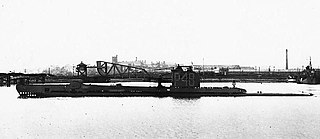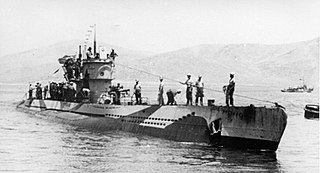German submarine U-556 was a Type VIIC U-boat of Nazi Germany's Kriegsmarine during World War II. She was laid down on 2 January 1940 at the Blohm & Voss yard in Hamburg as yard number 532, launched on 7 December 1940, and commissioned on 6 February 1941 under the command of Kapitänleutnant Herbert Wohlfarth, who commanded her for her entire career that lasted less than five months. U-556 conducted only two patrols, sinking six ships totalling 29,552 gross register tons (GRT) and damaging one other of 4,986 GRT, before she was sunk on 27 June 1941.
German submarine U-559 was a Type VIIC U-boat built for Nazi Germany's Kriegsmarine for service during World War II.

The River class, or Thames class, were a class of submarines built for the Royal Navy. Operating during the Second World War, the three boats of the class comprised Thames, Severn and Clyde. All the submarines were named after rivers in the United Kingdom. One was lost during the war and the rest taken out of service following it.

HMS Safari was a third batch S-class submarine built for the Royal Navy during World War II. Commissioned in 1942, she was assigned to operate in the Mediterranean Sea. During the course of the war, Safari sank twenty-five ships, most of which were Italian.

German submarine U-75 was a Type VIIB U-boat of Nazi Germany's Kriegsmarine during World War II. U-75 was moderately successful in her early career in the Battle of the Atlantic, but in autumn 1941 she was dispatched to the Mediterranean Sea with poor results, leading to the eventual destruction of the boat and her crew.
German submarine U-596 was a Type VIIC U-boat built for Nazi Germany's Kriegsmarine for service during World War II. She was laid down on 4 January 1941 by Blohm & Voss in Hamburg as yard number 572, launched on 17 September 1941 and commissioned on 13 November under Kapitänleutnant Gunter Jahn. He was replaced on 28 July 1943 by Oberleutnant zur See Victor-Whilhelm Nonn who was superseded by Oblt.z.S. Hans Kolbus in July 1944.

HMS P48 was a Royal Navy U-class submarine built by Vickers-Armstrong at Barrow-in-Furness. Commissioned on 18 June 1942, Vickers arranged for the wife of serving submarine Captain, Alister Mars of HMS Unbroken, Ting Mars and Commander of the cruiser Jamaica to officially launch P.48 at Barrow dockyard.
HMS Clyde was a submarine of the River class. She was built by Vickers Armstrong, Barrow and launched on 15 March 1934. Building was completed on 12 April 1935. Initially planned to be part of a class 20 strong, Clyde would be the third and final of the boats to be completed and launched.

HMS Thames (N71) was an ocean-going type of submarine of the River Class. She was built by Vickers Armstrong, Barrow and launched on 26 February 1932. She was completed on 14 September 1932, and after commissioning was assigned to the Mediterranean, stationed at Malta.

HMS P222 was a third-batch S-class submarine built for the Royal Navy during World War II. Commissioned in 1942, the boat had an uneventful first war patrol in the Alboran Sea. She intercepted the Vichy French merchant ship SS Mitidja in July, then provided protection for an Allied convoy to Malta in Operation Pedestal the next month. The navy intended that she was to be sighted on the surface by enemy aircraft to discourage potential attacks by surface warships. Though P222 did not encounter enemy forces, the convoy arrived at its destination on 15 August after sustaining severe losses. She then reconnoitred along the coast of Algeria in advance of Operation Torch, and was attacked by a French patrol ship, but sustained no damage.
German submarine U-557 was a Type VIIC U-boat built for Nazi Germany's Kriegsmarine for service during World War II. She was laid down on 6 January 1940, launched on 22 December 1940 and commissioned on 13 February 1941. Oberleutnant zur See Ottokar Arnold Paulssen was in command throughout her career. For her first three war patrols her 2nd Watch Officer was Herbert Werner, who later wrote the memoir of U-boat service, Iron Coffins. She sank six merchant ships and one warship, a total of 31,729 gross register tons (GRT) and 5,220 tons over four patrols.

German submarine U-74 was a Type VIIB U-boat of Nazi Germany's Kriegsmarine during World War II.

German submarine U-81 was a Type VIIC U-boat of the navy (Kriegsmarine) of Nazi Germany during World War II, famous for sinking the aircraft carrier HMS Ark Royal.
German submarine U-73 was a Type VIIB U-boat of Nazi Germany's Kriegsmarine during World War II. She was laid down by Vegesacker Werft, Germany as yard number 1 on 5 November 1939, launched on 27 July 1940 and commissioned on 30 September of the same year under Kapitänleutnant (Kptlt.) Helmut Rosenbaum.

German submarine U-77 was a Type VIIC U-boat of Nazi Germany's Kriegsmarine built by the Bremer Vulkan-Vegesacker Werft, Bremen-Vegesack. Her keel was laid down on 28 March 1940, by Bremer Vulkan of Bremen-Vegesack, Germany as yard number 5. She was launched on 23 November 1940 and commissioned on 18 January 1941, with Oberleutnant zur See Heinrich Schonder in command until 2 September 1942, when he was succeeded by Oblt.z.S. Otto Hartmann, who remained in charge until the U-boat's loss.
German submarine U-652 was a Type VIIC U-boat of Nazi Germany's Kriegsmarine during World War II. The submarine was laid down on 5 February 1940 at the Howaldtswerke yard at Hamburg, launched on 7 February 1941, and commissioned on 3 April 1941 under the command of Oberleutnant zur See Georg-Werner Fraatz.
German submarine U-410 was a Type VIIC U-boat built for Nazi Germany's Kriegsmarine during World War II, operating mainly in the Mediterranean. Her insignia was a sword & shield, she did not suffer any casualties until she was sunk.
German submarine U-97 was a Type VIIC U-boat built for Nazi Germany's Kriegsmarine for service during the Second World War. She carried out thirteen patrols during her career, sinking sixteen ships and damaging a seventeenth. She was a member of two wolfpacks.

The second HMS Wivern, was a Modified W-class destroyer of the British Royal Navy that saw service in World War II.

Italian submarine Tembien was an Adua-class submarine built for the Royal Italian Navy during the 1930s. It was named after a Tembien region of Ethiopia, where Italian troops fought two battles against more numerous Ethiopian troops during the Second Italo-Ethiopian War.










